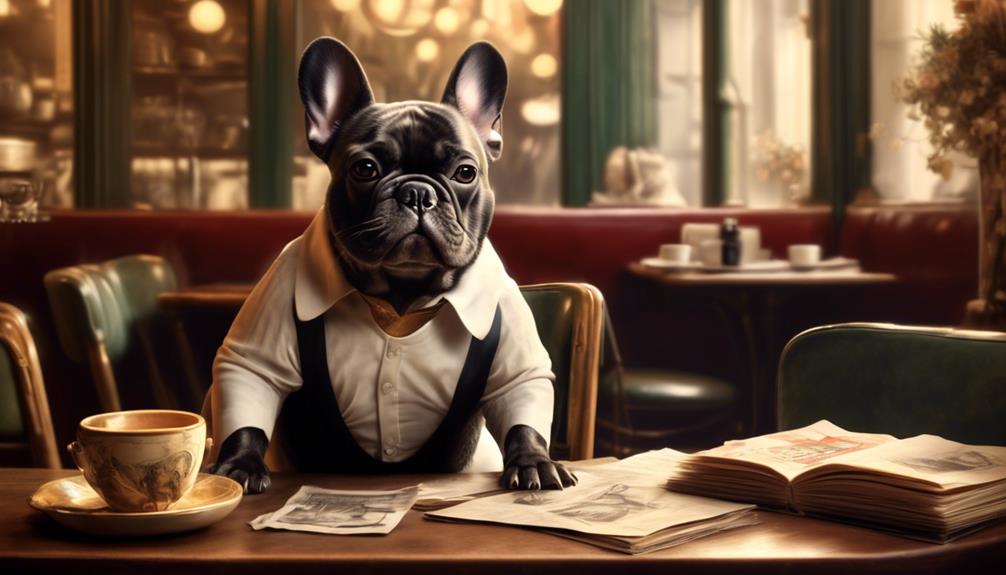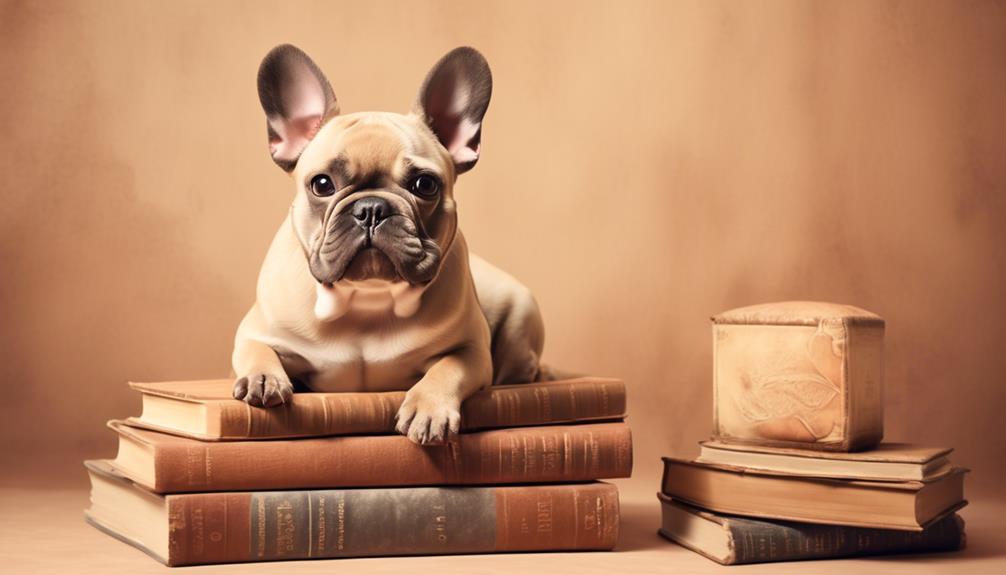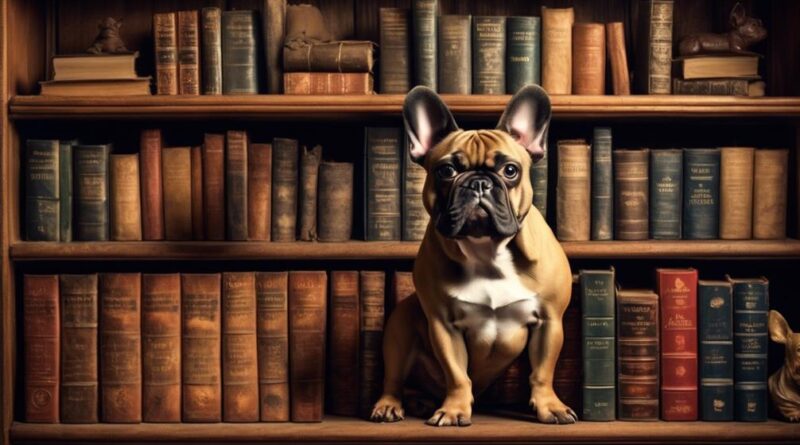7 Best Historical Literature References to French Bulldogs
If you're interested in exploring the historical connections between French Bulldogs and literature, you'll find compelling references in various literary works throughout the ages.
From Ancient Greek texts to contemporary fiction, these beloved canines have left their paw prints on the pages of some of the most influential writings in history.
Whether it's their portrayal in Shakespearean plays or their significance in Victorian novels, the presence of French Bulldogs in literature offers a fascinating glimpse into the cultural and literary landscape of different eras.
Each reference provides a unique insight into the evolving perceptions and roles of these endearing companions, making it a journey worth embarking on.
French Bulldogs in Ancient Greek Literature
Exploring ancient Greek literature uncovers intriguing references to the presence of French Bulldogs in various contexts, shedding light on their historical significance and role in ancient society. Ancient Greek symbolism often depicted dogs as loyal companions, guardians, and symbols of vigilance. These representations align with the characteristics of the modern French Bulldog, suggesting that they may have been revered for similar qualities in ancient Greece.
The historical breed development of the French Bulldog can also be traced back to ancient Greece. References to the Molossian dogs, an ancient Greek breed known for their strong build and protective nature, bear a striking resemblance to the French Bulldog. It's believed that these Molossian dogs were brought to France by Phoenician traders, where they were eventually crossed with local breeds, leading to the development of the French Bulldog as we know it today. These historical connections highlight the enduring presence of French Bulldogs throughout different periods, showcasing their long-standing importance in various cultures.
Furthermore, ancient Greek literature often showcased the bond between humans and dogs, emphasizing their companionship and loyalty. This portrayal aligns with the affectionate and devoted nature of French Bulldogs, indicating that these qualities have been valued for centuries. The presence of French Bulldogs in ancient Greek literature not only underscores their historical significance but also provides insight into the enduring admiration for this beloved breed.
French Bulldogs in Shakespearean Works
French Bulldogs frequently appear as symbolic representations of loyalty and companionship in several of Shakespeare's works. In Shakespearean tragedies, the loyal and faithful nature of French Bulldogs is often depicted through characters like Argos, who waits patiently for his master's return in 'The Odyssey.'
This unwavering loyalty is akin to the steadfastness of a French Bulldog. Additionally, in comedic roles in Shakespearean plays, French Bulldogs are often used to bring light-heartedness and joy to the scenes. Their playful and affectionate nature mirrors the humor and warmth found in these plays.
For instance, in 'A Midsummer Night's Dream,' the mischievous antics of the fairy Puck are accompanied by the presence of a charming French Bulldog, adding a delightful touch to the comedic atmosphere. Furthermore, in 'The Two Gentlemen of Verona,' Crab, the dog belonging to Launce, provides comedic relief with his endearing and loyal behavior, showcasing the beloved qualities of a French Bulldog.
Shakespeare's portrayal of French Bulldogs in both tragedies and comedies reflects their enduring presence as symbols of loyalty, companionship, and joy throughout literary history. These depictions not only highlight the timeless appeal of French Bulldogs but also emphasize their significance as beloved companions in both tragic and light-hearted narratives.
French Bulldogs in Victorian Era Novels
In many Victorian era novels, French Bulldogs are portrayed as loyal and cherished companions, adding depth and warmth to the narrative settings. These novels often depict French Bulldogs as fashionable accessories, matching the Victorian fashion of the time. The breed's popularity soared during the Victorian era, where they were often seen beside fashionable ladies, adorning their laps or walking alongside them in the park. This portrayal highlights the close bond between French Bulldogs and their owners, showcasing the breed's affectionate and devoted nature.
Victorian fashion greatly influenced the portrayal of French Bulldogs in novels of the era. The dogs were often described as having a certain elegance that complemented the elaborate attire of their owners. Their presence added a touch of charm and sophistication to the literary scenes, further solidifying their status as beloved companions.
Moreover, Victorian era novels shed light on the Bulldog breeding practices of the time. French Bulldogs were often bred selectively for their desirable traits, such as their compact size, distinctive bat ears, and gentle temperament. The novels subtly hint at the careful breeding practices aimed at producing French Bulldogs that perfectly fit into the Victorian lifestyle, both in appearance and demeanor. This attention to breeding reflects the value placed on the dogs as not just pets, but as integral parts of Victorian society.
French Bulldogs in 19th Century Art and Literature
The portrayal of French Bulldogs in 19th-century art and literature further solidifies their status as beloved companions, reflecting the breed's enduring appeal and significance in cultural expressions of the time.
In the 19th century, French Bulldogs weren't only popular as pets but also served as subjects in various paintings. Artists captured the charm and character of these dogs in their works, depicting them as cherished household members. Notable 19th-century French bulldog paintings include 'A Girl with a Dog' by Pierre-Auguste Renoir, which features a lovely French Bulldog sitting beside the girl, symbolizing loyalty and companionship.
In addition to their presence in art, French Bulldogs also held symbolic significance in 19th-century literature. In works of fiction and poetry, these dogs were often used to represent loyalty, courage, and steadfast companionship. Authors integrated French Bulldogs into their narratives to evoke feelings of warmth and affection, portraying them as faithful and loving companions to their human counterparts. One such example is found in the poetry of Elizabeth Barrett Browning, where the French Bulldog is used as a symbol of unwavering devotion and friendship.
French Bulldogs in Modernist Literature

Amid the shifting literary landscape of the modernist era, authors found new ways to integrate the endearing presence of the French Bulldog into their narratives, infusing their works with themes of companionship and resilience.
French Bulldogs in Urban Fiction
In urban fiction, French Bulldogs often symbolize loyalty and the struggle for survival in the bustling, concrete jungles of the city. These dogs serve as steadfast companions to the protagonists, offering a sense of stability and warmth in the midst of urban chaos. Authors use French Bulldogs to explore the complex dynamics of city life, portraying them as resilient creatures navigating through the harsh realities of urban existence.
French Bulldogs in Minimalist Poetry
Minimalist poets incorporate French Bulldogs as symbols of simplicity and emotional depth. These compact, muscular dogs become metaphors for the essential aspects of life, representing love, connection, and the profound beauty found in everyday moments. Through minimalist poetry, French Bulldogs evoke a sense of tranquility and contentment, reminding readers to appreciate the quiet, unassuming joys that enrich their lives.
In modernist literature, French Bulldogs transcend their roles as mere pets, becoming profound symbols that reflect the human experience in urban settings and minimalist landscapes. Their presence adds layers of meaning to the narratives, illustrating the enduring qualities of friendship and fortitude in a rapidly changing world.
French Bulldogs in Contemporary Fiction
Exploring the nuanced portrayal of French Bulldogs in contemporary fiction reveals their evolving significance as symbols of companionship and resilience.
In recent years, French Bulldogs have made their mark in popular culture, including contemporary films and pop culture trends.
In contemporary films, French Bulldogs have become iconic symbols of loyalty and love. They often play roles that reflect their real-life reputation as affectionate and loyal companions, endearing themselves to audiences and adding depth to the storytelling. These portrayals showcase the French Bulldog's ability to provide unwavering support and companionship, making them beloved characters in modern storytelling.
Moreover, French Bulldogs have also become prominent in pop culture trends, appearing in various forms of media and merchandise. Their distinctive appearance and charming personalities have made them popular choices for inclusion in fashion, art, and social media.
Their presence in these trends further solidifies their status as beloved symbols of companionship and resilience in contemporary society.
French Bulldogs in Poetry and Prose

Delving into poetry and prose, you'll encounter evocative depictions of French Bulldogs capturing their endearing presence and unwavering loyalty in literary works across the ages. French Bulldogs in modern poetry have been portrayed as steadfast companions, their distinctive physical traits often used as symbols of devotion and resilience. In literary symbolism, French Bulldogs have been employed to represent steadfastness and unwavering loyalty, becoming a recurring motif in various works.
Here are some notable instances where French Bulldogs have left their paw prints in the realm of poetry and prose:
- Modern Poetry:
Contemporary poets have beautifully woven the essence of French Bulldogs into their verses, portraying them as loyal guardians and beloved confidants. Their playful antics and unwavering companionship are often celebrated, evoking a sense of joy and comfort in the readers' hearts.
- Symbolism in Literature:
In the realm of literary symbolism, French Bulldogs have emerged as powerful representations of loyalty and resilience. Authors have skillfully integrated these beloved canines into their narratives, using them as symbols of unwavering devotion and steadfast support, adding depth and emotional resonance to their works.
- Enduring Presence:
French Bulldogs have made an enduring mark in the literary world, their presence transcending time and cultural boundaries. From classic poetry to modern prose, these beloved companions continue to inspire writers to craft heartfelt odes and poignant narratives, celebrating their unwavering loyalty and endearing charm.
French Bulldogs in Folktales and Mythology
French Bulldogs' enduring presence in literary works extends beyond poetry and prose, as their portrayal in folktales and mythology showcases their cultural significance and timeless appeal.
In various fairy tales, French Bulldogs have been depicted as loyal companions to heroes and heroines, often accompanying them on magical adventures. These tales often highlight the breed's intelligence, bravery, and unwavering loyalty, solidifying their place as revered figures in folklore.
In folklore, French Bulldogs are often portrayed as guardians or protectors, with their iconic bat-like ears and sturdy build symbolizing strength and protection. They're frequently depicted as wise and noble creatures, offering guidance and comfort to characters in mythical narratives. Their presence in folklore serves as a testament to their revered status in different cultures throughout history.
French Bulldogs also make appearances in mythology, where they're often associated with symbols of luck, fortune, and even supernatural powers. In some myths, they're depicted as magical beings with the ability to ward off evil spirits or bring good fortune to those they encounter. These mythological representations further emphasize the deep-rooted cultural significance of French Bulldogs and their enduring presence in storytelling traditions.
Frequently Asked Questions
What Are the Differences Between the Portrayal of French Bulldogs in Ancient Greek Literature Compared to Their Representation in Contemporary Fiction?
In ancient Greek literature, French Bulldogs were often portrayed as symbols of loyalty and protection. They were revered for their fierce and courageous nature.
In contemporary fiction, however, their portrayal has shifted. French Bulldogs are now emphasized for their companionship and charm. They are often depicted as beloved family pets.
The ancient vs. contemporary portrayal of French Bulldogs in literature reflects changing cultural attitudes towards these animals. It highlights their adaptability and enduring appeal in human society.
Were French Bulldogs Commonly Kept as Pets in the Victorian Era, and How Were They Perceived in Victorian Novels?
In the Victorian era, French Bulldogs were commonly kept as pets and were perceived as beloved companions in Victorian novels. Their portrayal in historical literature reflects them as cherished household members, often depicted as loyal and affectionate.
The representation of French Bulldogs in Victorian literature differs from their portrayal in ancient Greek literature and contemporary fiction, showcasing the evolving perception of these endearing pets throughout history.
How Did French Bulldogs Become a Popular Subject in 19th Century Art and Literature, and What Significance Did They Hold During This Time?
French bulldogs became a popular subject in 19th-century art and literature due to their charm and unique appearance. Their cultural significance during this time reflected a shift towards valuing companionship and loyalty, as they were often portrayed as loyal and affectionate companions in literature and art.
The breed's rise in popularity also paralleled the growing interest in exotic and unique pets, making them a symbol of fashion and status in 19th-century society.
What Unique Characteristics of French Bulldogs Are Highlighted in Modernist Literature, and How Are They Used Symbolically or Thematically?
In modernist literature, French Bulldogs are often used as a symbolic representation of loyalty, companionship, and resilience. Their unique characteristics, such as their distinctive bat-like ears and expressive eyes, are highlighted to convey deeper thematic significance.
In contemporary fiction, French Bulldogs are portrayed as steadfast companions, echoing their portrayal in ancient Greek literature as loyal protectors. This portrayal of the breed in literature reflects their enduring appeal and timeless qualities.
In What Ways Do French Bulldogs Appear in Folktales and Mythology, and What Cultural Significance Do They Hold in These Narratives?
French Bulldogs in folklore and mythology have long held cultural significance, portraying loyalty and protection. They were cherished Victorian era pets and appeared in 19th-century art.
Their symbolism in modernist literature reflects their tenacity and resilience. Comparing historical portrayals reveals their enduring appeal as beloved companions.
French Bulldogs in cultural narratives embody qualities of bravery and companionship, making them timeless symbols of devotion and strength.
Conclusion
So there you have it – French Bulldogs have made their mark in historical literature across various time periods and genres.
From ancient Greek texts to contemporary fiction, these beloved pups have captured the hearts of writers and readers alike.
Their presence in poetry, prose, and even mythology speaks to their enduring appeal and significance in human culture.
French Bulldogs have truly left a paw print on the pages of history.
